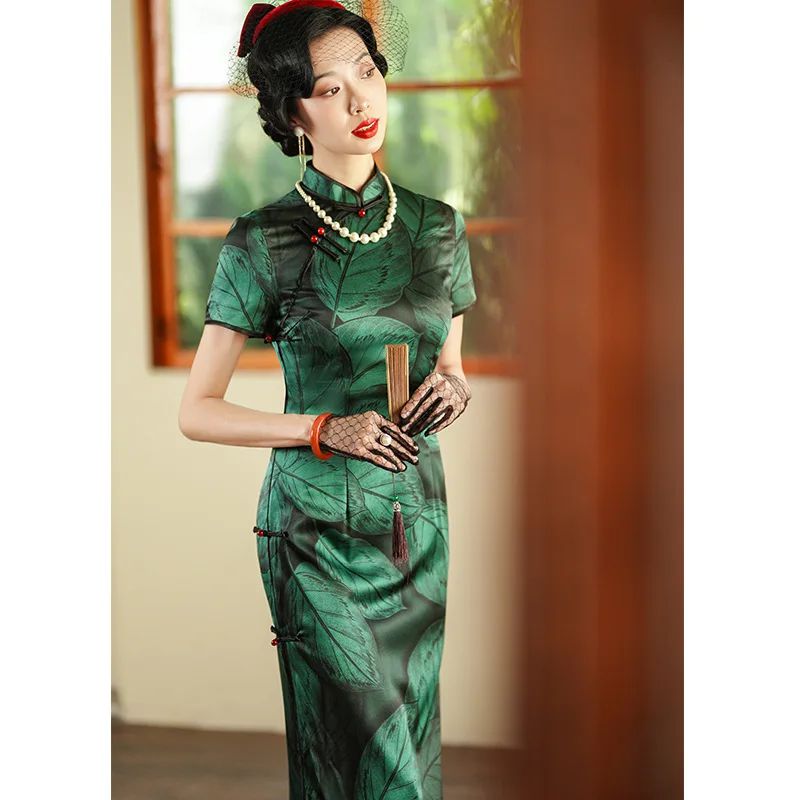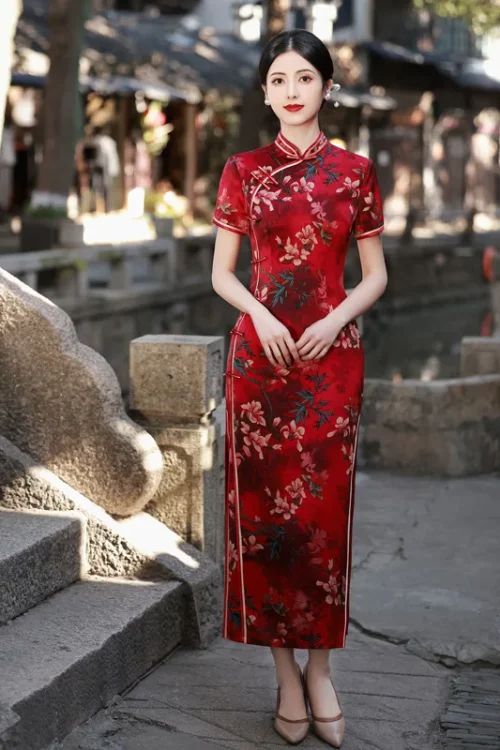El Qipao: A Symbol of Chinese Identity and Tradition
The qipao, an iconic Chinese garment, has played a pivotal role in shaping Chinese identity and tradition throughout history. Its origins can be traced back to the Qing dynasty, where it was worn by Manchu women as a symbol of their cultural heritage. Over time, the qipao evolved into a versatile prenda, adopted by women from all walks of life.

Transformation During the Republican Era
During the Republican era, the qipao underwent a transformation, becoming a symbol of modernity and liberation. It was embraced by women seeking to break free from traditional gender roles and embrace a more cosmopolitan lifestyle. The qipao’s popularity soared, and it became a staple in the wardrobes of fashionable women in Shanghai and other major cities.
International Recognition
In the mid-20th century, the qipao gained international recognition as a symbol of Chinese culture. It was worn by prominent figures such as Soong Mei-ling, the wife of Chiang Kai-shek, who introduced the garment to Western audiences. The qipao’s elegant silhouette and intricate designs captivated the world, becoming a symbol of Chinese beauty and sophistication.
Suppression and Resurgence
However, during the Cultural Revolution, the qipao was suppressed as a symbol of bourgeois decadence. It was replaced by more utilitarian clothing that reflected the egalitarian ideals of the time. After the Cultural Revolution, the qipao gradually regained its popularity, but it took on a new meaning.
Contemporary Celebrations
Today, the qipao is celebrated as a symbol of Chinese heritage and cultural pride. It is worn by women of all ages and backgrounds, from traditional festivals to formal occasions. The qipao has also become a popular fashion item, inspiring contemporary designers to create modern interpretations of the classic garment.
Enduring Significance
The qipao’s enduring significance lies in its ability to transcend time and fashion trends. It has evolved from a symbol of cultural identity to a representation of modernity and liberation, and ultimately, a testament to the enduring spirit of Chinese culture. As a living symbol of Chinese heritage, the qipao continues to inspire and captivate generations of Chinese people and the world beyond.
The Evolution of the Qipao: From Imperial Court to Modern Fashion
The qipao has played a pivotal role in shaping China’s cultural identity. Its origins can be traced back to the Manchu court during the Qing dynasty, where it was worn as a formal robe by women. Over time, the qipao evolved into a symbol of Chinese femininity and elegance, transcending its initial purpose and becoming an integral part of the country’s fashion landscape.

Transformative Years
During the Republican era, the qipao underwent a significant transformation. It was embraced by women seeking to break free from traditional gender roles and embrace modernity. The garment’s silhouette became more form-fitting, accentuating the female figure and reflecting the changing social norms of the time. The qipao became a symbol of liberation and empowerment, representing the aspirations of a generation of women.
Global Fashion Icon
In the post-war era, the qipao continued to evolve, adapting to the changing tastes and influences of the time. It was adopted by Western designers, who incorporated elements of the garment into their own creations. The qipao became a global fashion icon, representing the allure and sophistication of Chinese culture.
A Cherished Symbol
Today, the qipao remains a cherished symbol of Chinese heritage. It is worn by women of all ages and backgrounds, from traditional festivals to modern fashion shows. The garment has transcended its original function and become a versatile piece that can be dressed up or down, reflecting the diverse nature of Chinese culture.
Importancia cultural
The qipao’s cultural significance extends beyond its aesthetic appeal. It is a tangible link to China’s past, embodying the nation’s history, traditions, and values. The garment has been featured in countless works of art, literature, and film, further solidifying its place in the Chinese cultural consciousness.
Conclusión
In conclusion, the qipao is more than just a garment; it is a cultural artifact that has played a profound role in shaping Chinese history and identity. From its origins in the imperial court to its modern-day status as a global fashion icon, the qipao has consistently reflected the evolving social and cultural landscape of China. As a symbol of femininity, elegance, and cultural heritage, the qipao continues to captivate and inspire generations of Chinese people and beyond.
The Qipao in Film and Literature: Exploring Cultural Representation
Exploring Cultural Significance
The qipao, an iconic Chinese dress, has played a pivotal role in shaping the nation’s cultural identity. Its origins can be traced back to the Manchu dynasty, where it was worn by women of the ruling class. Over time, the qipao evolved into a symbol of Chinese femininity and elegance.

Popularity in the Early 20th Century
In the early 20th century, the qipao gained widespread popularity among women of all social classes. It became a symbol of modernization and liberation, as women began to embrace Western influences. The qipao’s form-fitting silhouette and high neckline reflected the changing social norms of the time.
The Qipao in Cinema
During the Republican era, the qipao became a staple of Chinese cinema. Actresses such as Ruan Lingyu and Zhou Xuan immortalized the dress on screen, making it an enduring symbol of Chinese glamour. The qipao’s association with the silver screen further cemented its cultural significance.
Literary Exploration
In literature, the qipao has been used as a powerful literary device. Writers such as Eileen Chang and Zhang Ailing have explored the complex relationship between women and the qipao. In their works, the dress becomes a symbol of both desire and repression, reflecting the social constraints faced by women in Chinese society.
Political and Social Debate
Beyond its cultural significance, the qipao has also been a subject of political and social debate. During the Cultural Revolution, the qipao was banned as a symbol of bourgeois decadence. However, in recent years, there has been a resurgence of interest in the dress, as it has become a symbol of Chinese cultural heritage.
Contemporary Versatility
Today, the qipao continues to be worn by women of all ages and backgrounds. It has become a versatile garment, adapted to suit different occasions and styles. From traditional silk qipaos to modern interpretations, the dress remains a testament to the enduring cultural significance of Chinese fashion.
Conclusión
In conclusion, the qipao is more than just a garment; it is a symbol of Chinese history, culture, and identity. Its evolution over time reflects the changing social and political landscape of China. Through its representation in film, literature, and fashion, the qipao continues to inspire and captivate audiences around the world.
